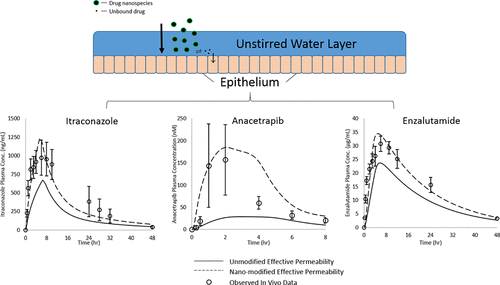当前位置:
X-MOL 学术
›
Mol. Pharmaceutics
›
论文详情
Our official English website, www.x-mol.net, welcomes your
feedback! (Note: you will need to create a separate account there.)
Practical Approach to Modeling the Impact of Amorphous Drug Nanoparticles on the Oral Absorption of Poorly Soluble Drugs.
Molecular Pharmaceutics ( IF 4.5 ) Pub Date : 2019-12-06 , DOI: 10.1021/acs.molpharmaceut.9b00889 Aaron M. Stewart , Michael E. Grass
Molecular Pharmaceutics ( IF 4.5 ) Pub Date : 2019-12-06 , DOI: 10.1021/acs.molpharmaceut.9b00889 Aaron M. Stewart , Michael E. Grass

|
Recently published studies have proposed that amorphous drug nanoparticles in gastrointestinal fluids may be beneficial for the absorption of poorly soluble compounds. Nanosized drug particles are known to provide rapid dissolution rates and, in some instances, a slight increase in solubility. However, in recent studies, the differences observed in vivo could not be explained solely by these attributes. Given the high dose and very low aqueous solubility of the study compounds, rapid equilibration to the drug-saturated solubility in gastrointestinal fluid would occur independent of the presence of nanoparticles. Alternatively, it has been proposed that drug nanoparticles (ca. ≤ 200 to 300 nm) may provide a "shuttle" for drug across the unstirred water layer (UWL) adjacent to the intestinal epithelium, particularly for low solubility/lipophilic compounds where absorption may be largely UWL-limited. This transport mechanism would result in a higher unbound drug concentration at the surface of the epithelium for absorption. This study evaluates this mechanism using a simple modification of the effective permeability to account for the effect of drug nanoparticles diffusing across the UWL. The modification can be made using inputs for solubility and nanoparticle size. The permeability modification was evaluated using three published case studies for amorphous formulations of itraconazole, anacetrapib, and enzalutamide, where the formation of amorphous drug nanoparticles upon dissolution resulted in improved drug absorption. Absorption modeling was performed using GastroPlus to assess the impact of the nanomodified permeability method on the accuracy of model prediction compared to in vivo data. Simulation results were compared to those for baseline simulations using an unmodified effective permeability. The results show good agreement using the nanomodified permeability, which described the data better than the standard baseline predictions. The nanomodified permeability method can be a suitable, fit-for-purpose in silico approach for evaluating or predicting oral absorption of poorly soluble, UWL-limited drugs from formulations that produce a significant number of amorphous drug nanoparticles.
中文翻译:

模拟无定形药物纳米颗粒对难溶性药物口服吸收影响的实用方法。
最近发表的研究提出,胃肠道液体中的无定形药物纳米粒子可能对吸收难溶性化合物有益。已知纳米尺寸的药物颗粒提供快速的溶解速率,并且在某些情况下溶解度略有增加。但是,在最近的研究中,不能仅通过这些属性来解释体内观察到的差异。考虑到研究化合物的高剂量和极低的水溶性,与纳米颗粒的存在无关,会迅速达到药物在胃肠液中的饱和溶解度的平衡。或者,有人提出药物纳米粒子(约≤200至300 nm)可以为药物提供“穿梭”的作用,使药物跨过与肠上皮相邻的未搅拌水层(UWL),特别是对于低溶解度/亲脂性化合物,其中吸收可能在很大程度上受UWL限制。这种转运机制将导致上皮表面吸收的未结合药物浓度更高。这项研究使用有效渗透率的简单修改来评估这种机制,以解决药物纳米粒子在整个UWL中扩散的影响。可以使用溶解度和纳米颗粒尺寸的输入进行修饰。使用三个已发表的案例研究对伊曲康唑,anacetrapib和enzalutamide的无定形制剂进行了通透性评估,其中溶解后形成无定形药物纳米颗粒可改善药物的吸收。与体内数据相比,使用GastroPlus进行了吸收建模,以评估纳米改性渗透性方法对模型预测准确性的影响。使用未修改的有效磁导率将模拟结果与基线模拟的结果进行比较。结果表明,使用纳米改性的渗透率具有良好的一致性,其比标准基线预测更好地描述了数据。纳米改性的渗透性方法可以是合适的,适合用途的计算机模拟方法,用于从产生大量无定形药物纳米颗粒的制剂中评估或预测难溶的,受UWL限制的药物的口服吸收。结果表明,使用纳米改性的渗透率具有良好的一致性,其描述的数据优于标准的基线预测。纳米改性的渗透性方法可以是合适的,适合用途的计算机模拟方法,用于从产生大量无定形药物纳米颗粒的制剂中评估或预测难溶的,受UWL限制的药物的口服吸收。结果表明,使用纳米改性的渗透率具有良好的一致性,其描述的数据优于标准的基线预测。纳米改性的渗透性方法可以是合适的,适合用途的计算机模拟方法,用于从产生大量无定形药物纳米颗粒的制剂中评估或预测难溶的,受UWL限制的药物的口服吸收。
更新日期:2019-12-07
中文翻译:

模拟无定形药物纳米颗粒对难溶性药物口服吸收影响的实用方法。
最近发表的研究提出,胃肠道液体中的无定形药物纳米粒子可能对吸收难溶性化合物有益。已知纳米尺寸的药物颗粒提供快速的溶解速率,并且在某些情况下溶解度略有增加。但是,在最近的研究中,不能仅通过这些属性来解释体内观察到的差异。考虑到研究化合物的高剂量和极低的水溶性,与纳米颗粒的存在无关,会迅速达到药物在胃肠液中的饱和溶解度的平衡。或者,有人提出药物纳米粒子(约≤200至300 nm)可以为药物提供“穿梭”的作用,使药物跨过与肠上皮相邻的未搅拌水层(UWL),特别是对于低溶解度/亲脂性化合物,其中吸收可能在很大程度上受UWL限制。这种转运机制将导致上皮表面吸收的未结合药物浓度更高。这项研究使用有效渗透率的简单修改来评估这种机制,以解决药物纳米粒子在整个UWL中扩散的影响。可以使用溶解度和纳米颗粒尺寸的输入进行修饰。使用三个已发表的案例研究对伊曲康唑,anacetrapib和enzalutamide的无定形制剂进行了通透性评估,其中溶解后形成无定形药物纳米颗粒可改善药物的吸收。与体内数据相比,使用GastroPlus进行了吸收建模,以评估纳米改性渗透性方法对模型预测准确性的影响。使用未修改的有效磁导率将模拟结果与基线模拟的结果进行比较。结果表明,使用纳米改性的渗透率具有良好的一致性,其比标准基线预测更好地描述了数据。纳米改性的渗透性方法可以是合适的,适合用途的计算机模拟方法,用于从产生大量无定形药物纳米颗粒的制剂中评估或预测难溶的,受UWL限制的药物的口服吸收。结果表明,使用纳米改性的渗透率具有良好的一致性,其描述的数据优于标准的基线预测。纳米改性的渗透性方法可以是合适的,适合用途的计算机模拟方法,用于从产生大量无定形药物纳米颗粒的制剂中评估或预测难溶的,受UWL限制的药物的口服吸收。结果表明,使用纳米改性的渗透率具有良好的一致性,其描述的数据优于标准的基线预测。纳米改性的渗透性方法可以是合适的,适合用途的计算机模拟方法,用于从产生大量无定形药物纳米颗粒的制剂中评估或预测难溶的,受UWL限制的药物的口服吸收。











































 京公网安备 11010802027423号
京公网安备 11010802027423号